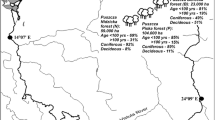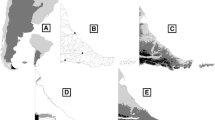Abstract
Transformation of coppices to high forests has caused fundamental changes in site conditions and a decline of many species across Central Europe. Nevertheless, some formerly coppiced forests still harbour a number of the declining species and have become biodiversity hotspots in the changing landscape. We focused on the best-preserved remnant of formerly grazed and coppiced subcontinental oak forest in the Czech Republic – the Dúbrava forest near the town of Hodonín. To improve our understanding of the ecology of declining species, we studied local habitat requirements of vascular plants most endangered at the national level. We recorded vegetation composition and sampled important site variables in plots with the largest populations of endangered species and in additional plots placed randomly across all major forest habitats. We demonstrated that sites with endangered species have a highly uneven distribution in ecological space and that their species composition is often similar to open-canopy oak forests. Within this habitat, the endangered species are concentrated in places with a high light availability and high soil pH. Light-demanding species characteristic of subcontinental oak forests are the best indicators of these sites, while broadly distributed shade-tolerant and nutrient-demanding species avoid them. These results support the view that the occurrence of many endangered species in the Dúbrava forest is a legacy of the long history of traditional management that kept the canopies open. Light-demanding species are now threatened by ongoing successional changes. Therefore, active conservation measures are recommended, including opening up the canopies, early thinning of young stands, control of expansive and invasive species and understorey grazing or mowing.


Similar content being viewed by others
References
Baeten L, Bauwens B, De Schrijver A, De Keersmaeker L, Van Calster H, Vandekerkhove K, Roelandt B, Beeckman H, Verheyen K (2009) Herb layer changes (1954–2000) related to the conversion of coppice-with-standards forest and soil acidification. Appl Veg Sci 12:187–197
Berg Å, Ehnström B, Gustafsson L, Hallingbäck T, Jonsell M, Weslien J (1994) Threatened plant, animal, and fungus species in Swedish forests: distribution and habitat associations. Conservation Biol 8:718–731
Berg Å, Ehnström B, Gustafsson L, Hallingbäck T, Jonsell M, Weslien J (1995) Threat levels and threats to red-listed species in Swedish forests. Conservation Biol 9:1629–1633
Brunet J, Hedwall P-O, Holmström E, Wahlgren E (2016) Disturbance of the herbaceous layer after invasion of an eutrophic temperate forest by wild boar. Nordic J Bot 34:120–128
Chytrý M (2012) Vegetation of the Czech Republic: diversity, ecology, history and dynamics. Preslia 84:427–504
Chytrý M, Horák J (1997) Plant communities of the thermophilous oak forests in Moravia. Preslia 68:193–233
Chytrý M, Kučera T, Kočí M, Grulich V & Lustyk P (eds) (2010) Katalog biotopů České republiky. Ed. 2 (Habitat catalogue of the Czech Republic. Ed. 2). AOPK ČR, Prague
Chytrý M, Tichý L, Roleček J (2003) Local and regional patterns of species richness in Central European vegetation types along the pH/calcium gradient. Folia Geobot 38:429–442
Conrad O, Bechtel B, Bock M, Dietrich H, Fischer E, Gerlitz L, Wehberg J, Wichmann V, Böhner J (2015) System for Automated Geoscientific Analyses (SAGA) v. 2.1.4. Geosci Model Developm 8:1991–2007
Dengler J, Chytrý M, Ewald J (2008) Phytosociology. In Jørgensen SE, Fath BD (eds) Encyclopedia of ecology. Elsevier, Oxford, pp 2767–2779
Ellenberg H, Weber HE, Düll R, Wirth V, Werner W, Paulissen D (1992) Zeigerwerte von Pflanzen in Mitteleuropa. Scripta Geobot 18:1–248
Ewald J (2003) The calcareous riddle: Why are there so many calciphilous species in the Central European flora? Folia Geobot 38:357–366
Formánek E (1887) Květena Moravy a rakouského Slezska (Flora of Moravia and Austrian Silesia). Edvard Formánek, Brno
Gabrielová J, Münzbergová Z, Tackenberg O, Chrtek J (2013) Can we distinguish plant species that are rare and endangered from other plants using their biological traits? Folia Geobot 48:449–466
Gaskin GJ, Miller JD (1996) Measurement of soil water content using a simplified impedance measuring technique. J Agric Eng Res 63:153–159
Grandcolas P, Nattier R, Trewick S (2014) Relict species: a relict concept? Trends Ecol Evol 29:655–663
Grulich V (2012) Red List of vascular plants of the Czech Republic, 3rd edition. Preslia 84:631–645
Hájková P, Roleček J, Hájek M, Horsák M, Fajmon K, Polák M, Jamrichová E (2011) Prehistoric origin of the extremely species-rich semi-dry grasslands in the Bílé Karpaty Mts (Czech Republic and Slovakia). Preslia 83:185–204
Hédl R, Kopecký M, Komárek J (2010) Half a century of succession in a temperate oakwood: from species-rich community to mesic forest. Diversity & Distrib 16:267–276.
Hofmeister J, Mihaljevič M, Hošek J (2004) The spread of ash (Fraxinus excelsior) in some European oak forests: an effect of nitrogen deposition or successional change? Forest Ecol Managem 203:35–47
Hothorn T, Hornik K, van de Wiel MA, Zeileis A (2006) A Lego system for conditional inference. Amer Statistician 60:257–263
Hruby J (1926) Göding in Mähren und seine Umgebung. Čas Morav Zemsk Mus Brno 24:60–97
Iversen J (1958) The bearing of glacial and interglacial epochs on the formation and extinction of plant taxa. Uppsala Univ Årsskr 6:210–215
Jakubowska-Gabara J (1996) Decline of Potentillo albae-Quercetum Libb. 1933 phytocoenoses in Poland. Vegetatio 124:45–59
Jamrichová E, Szabó P, Hédl R, Kuneš P, Bobek P, Pelánková B (2013) Continuity and change in the vegetation of a Central European oakwood. The Holocene 23:46–56
Kirby K, Watkins C (eds) (2015) Europe’s changing woods and forests: from wildwood to managed landscapes. CABI, London
Konvička M, Čížek L, Beneš J (2004) Ohrožený hmyz nížinných lesů: ochrana a management (Endangered insects of lowland forests: conservation and management). Sagittaria, Olomouc
Konvicka M, Novak J, Benes J, Fric Z, Bradley J, Keil P, Hrcek J, Chobot K, Marhoul P (2008) The last population of the Woodland Brown butterfly (Lopinga achine) in the Czech Republic: habitat use, demography and site management. J Insect Conserv 12:549–560
Kopecký M, Čížková Š (2010) Using topographic wetness index in vegetation ecology: Does the algorithm matter? Appl Veg Sci 13:450–459
Kubát K, Hrouda L, Chrtek J Jun., Kaplan Z, Kirschner J, Štěpánek J (2002) Klíč ke květeně České republiky (Key to the flora of the Czech Republic). Academia, Praha
Kuneš P, Svobodová-Svitavská H, Kolář J, Hajnalová M, Abraham V, Macek M, Tkáč P, Szabó P (2015) The origin of grasslands in the temperate forest zone of east-central Europe: long-term legacy of climate and human impact. Quatern Sci Rev 116:15–27
Kwiatkowska AJ, Wyszomirski T (1988) Decline of Potentillo albae-Quercetum phytocoenoses associated with the invasion of Carpinus betulus. Vegetatio 75:49–55
Lang G (1994) Quartäre Vegetationsgeschichte Europas. Gustav Fischer Verlag, Jena
Ložek V (2007) Zrcadlo minulosti: česká a slovenská krajina v kvartéru (Mirror of the past: Czech and Slovak landscape in the Quaternary). Dokořán, Praha
Milner JM, Bonenfant C, Mysterud A, Gaillard JM, Csanyi S, Stenseth NC (2006) Temporal and spatial development of red deer harvesting in Europe: biological and cultural factors. J Appl Ecol 43:721–734
Müllerová J, Szabó P, Hédl R (2014) The rise and fall of traditional forest management in southern Moravia: a history of the past 700 years. Forest Ecol Managem 331:104–115
Müllerová J, Hédl R, Szabó P (2015) Coppice abandonment and its implications for species diversity in forest vegetation. Forest Ecol Managem 343:88–100
Naaf T, Wulf M (2010) Habitat specialists and generalists drive homogenization and differentiation of temperate forest plant communities at the regional scale. Biol Conservation 143:848–855
NCA CR (2011) Habitat mapping layer [electronic georeferenced database]. Version 2011. Nature Conservation Agency of the Czech Republic, Prague, Accessed 5 Sept 2011
Nobis M, Hunziker U (2005) Automatic thresholding for hemispherical canopy-photographs based on edge detection. Agric Forest Meteorol 128:243–250
Novák V, Pelíšek J (1943) Stručná charakteristika půd na přesypových pískách v lesní oblasti Dubrava u Hodonína (Brief characteristics of soils on eolian sand in the forest region of Dubrava near Hodonín). Lesn Práce 8:225–235
Pärtel M (2002) Local plant diversity patterns and evolutionary history at the regional scale. Ecology 83:2361–2366
Pokorný P, Kuneš P (2005) Holocene acidification process recorded in three pollen profiles from Czech sandstone and river terrace environments. Ferrantia 44:101–107
Pokorný P, Chytrý M, Juřičková L, Sádlo J, Novák J, Ložek V (2015) Mid-Holocene bottleneck for central European dry grasslands: Did steppe survive the forest optimum in northern Bohemia, Czech Republic? The Holocene 25:716–726
R Core Team (2014) R: a language and environment for statistical computing. R Foundation for Statistical Computing, Vienna, Austria. Available at http://www.R-project.org
Rackham O (2003) Ancient woodland: its history, vegetation and uses in England. Castlepoint Press, Dalbeattie
Řepka R (2009) Druhová diverzita vyšších rostlin versus lesnický management v evropsky významné lokalitě (EVL) Hodonínská Doubrava (Vascular plant species richness versus forestry management in the SCI Hodonínská Doubrava). Zprávy Čes Bot Společn Mater 24:111–120
Roleček J (2007) Formalized classification of thermophilous oak forests in the Czech Republic: What brings the Cocktail method? Preslia 79:1–21
Roleček J (2013) Thermophilous oak forests. Quercetea pubescentis. In Chytrý M (ed) Vegetation of the Czech Republic 4. Forest and scrub vegetation. Academia, Praha, pp 296–337
Roleček J, Hájek M, Karlík P, Novák J (2015) Reliktní vegetace na mezických stanovištích (Relict vegetation on mesic sites). Zprávy Čes Bot Společn 50:201–245
Rybníček K (1983) The environmental evolution and infilling process of a former lake near Vracov (Czechoslovakia). Hydrobiologia 103:247–250
Sádlo J (2000) Původ travinné vegetace slatin v Čechách: sukcese kontra cenogeneze. Preslia 72:495–506
Šmarda F (1961) Rostlinná společenstva území přesypových písků lesa Doubravy u Hodonína (Plant communities of the eolian sand area in Doubrava forest near Hodonín). Práce Brněnské základny Českoslov Akad věd 413:1–56
Szabó P (2013) The end of common uses and traditional management in a Central European wood. In Rotherham ID (ed) Cultural severance and the environment. The ending of traditional and customary practice on commons and landscapes managed in common. Springer Netherlands, Dordrecht, pp 205–213
Tichý L (2002) JUICE, software for vegetation classification. J Veg Sci 13:451–453
Vera FWM (2000) Grazing ecology and forest history. CABI, New York
Verheyen K, Baeten L, De Frenne P, Bernhardt-Römermann M, Brunet J, Cornelis J, Decocq G, Dierschke H, Eriksson O, Hédl R, Heinken T, Hermy M, Hommel P, Kirby K, Naaf T, Peterken G, Petřík P, Pfadenhauer J, Van Calster H, Walther G-R, Wulf M, Verstraeten G (2012) Driving factors behind the eutrophication signal in understorey plant communities of deciduous temperate forests J Ecol 100:352–365
Vesecký A (1961) Podnebí Československé socialistické republiky. Tabulky (Climate of the Czechoslovak Socialist Republic. Tables). Hydrometeorologický ústav, Praha
Vild O, Roleček J, Hédl R, Kopecký M, Utinek D (2013) Experimental restoration of coppice-with-standards: response of understorey vegetation from the conservation perspective. Forest Ecol Managem 310:234–241
Ward AI (2005) Expanding ranges of wild and feral deer in Great Britain. Mammal Rev 35:165–173
Wood A, Stedman-Edwards P, Mang J (eds) (2000) The root causes of biodiversity loss. Earthscan, London
Acknowledgements
Our thanks go out to Martin Kopecký for calculation of the convergence index, Martina Fabšičová, Pavel Unar, Vladan Riedl and Martin Kopecký for help with vegetation sampling within project IAA600050812, Radim Hédl for kindly providing soil chemistry data acquired within project IAA600050812, David Zelený for the discussion regarding ordination methods and Jan W. Jongepier for improving our English. This paper was produced as part of the project ‘Coppice forests as the production and biological alternative for the future’ (No. CZ.1.07/2.3.00/20.0267) with financial contribution of the EC and the state budget of the Czech Republic. Besides, the research leading to these results received funding from the European Research Council under the European Union’s Seventh Framework Programme (FP7/2007–2013) / ERC Grant agreement No. 278065, and the long-term research project RVO 67985939 from the Czech Academy of Sciences.
Author information
Authors and Affiliations
Corresponding author
Rights and permissions
About this article
Cite this article
Roleček, J., Vild, O., Sladký, J. et al. Habitat requirements of endangered species in a former coppice of high conservation value. Folia Geobot 52, 59–69 (2017). https://doi.org/10.1007/s12224-016-9276-6
Received:
Accepted:
Published:
Issue Date:
DOI: https://doi.org/10.1007/s12224-016-9276-6




